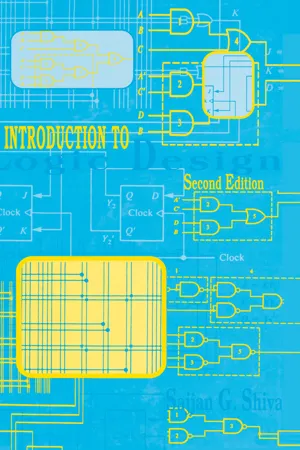
This is a test
- 628 pages
- English
- ePUB (mobile friendly)
- Available on iOS & Android
eBook - ePub
Introduction to Logic Design
Book details
Book preview
Table of contents
Citations
About This Book
The second edition of this text provides an introduction to the analysis and design of digital circuits at a logic, instead of electronics, level. It covers a range of topics, from number system theory to asynchronous logic design. A solution manual is available to instructors only. Requests must be made on official school stationery.
Frequently asked questions
At the moment all of our mobile-responsive ePub books are available to download via the app. Most of our PDFs are also available to download and we're working on making the final remaining ones downloadable now. Learn more here.
Both plans give you full access to the library and all of Perlego’s features. The only differences are the price and subscription period: With the annual plan you’ll save around 30% compared to 12 months on the monthly plan.
We are an online textbook subscription service, where you can get access to an entire online library for less than the price of a single book per month. With over 1 million books across 1000+ topics, we’ve got you covered! Learn more here.
Look out for the read-aloud symbol on your next book to see if you can listen to it. The read-aloud tool reads text aloud for you, highlighting the text as it is being read. You can pause it, speed it up and slow it down. Learn more here.
Yes, you can access Introduction to Logic Design by Sajjan G. Shiva in PDF and/or ePUB format, as well as other popular books in Technology & Engineering & Electrical Engineering & Telecommunications. We have over one million books available in our catalogue for you to explore.
Information
1
Number Systems and Codes
1.1 Digital System Organization
We are surrounded today by a myriad of digital devices. Digital watches, electronic calculators, digital meters, microprocessors, and digital computers are all examples of such systems. A digital system manipulates data that are composed of a finite number of discrete elements. The results that the digital system produces are also made up of a set of discrete elements. In contrast, an analog system manipulates data that are represented in a continuous form, producing results that also appear in continuous form. In electronic digital systems, the discrete elements of data correspond to signals which are either voltage levels or current magnitudes. Each specified voltage level can represent an element of data. The signal thus can be at only one of these specified levels. In an analog system, signals assume values in a continuous range of voltage.
For example, the signals in a digital system might be restricted to two levels (0 and +5 volts), corresponding to the two discrete elements of information, while analog signals may take any value in the range of +5 to –5 volts. Compared with analog systems, digital systems are more accurate and reliable. Hence, they are replacing analog systems wherever possible, although for certain applications analog systems are clearly superior. In order to introduce the terminology, we will now examine two popular digital devices.
An electronic calculator is a digital device in which input data are composed of discrete values entered through the keyboard, and the instructions to manipulate the data are also entered through the keyboard by means of the function keys. The output is a set of discrete values represented as digits on the display. In a programmable calculator, the sequence of instructions (i.e., the program) is stored in the calculator memory and used repeatedly on various sets of input data to produce results.
Figure 1.1 shows the components of a digital computer, the most general digital device. The program to manipulate the data is first brought into the memory unit through the input device. The data to be processed are then brought into the memory unit, also through the input device. The control unit fetches instructions from the program stored in the memory one at a time, analyzes each instruction, and instructs the processing unit to perform the operations called for by the instruction. The results produced by the processing unit are forwarded to the memory unit for storag...
Table of contents
- Cover
- Half Title
- Title Page
- Copyright Page
- Dedication
- Table of Contents
- Preface
- 1 Number Systems and Codes
- 2 Boolean Algebra
- 3 Minimization of Boolean Functions
- 4 Combinational Circuits
- 5 Popular Combinational Circuits
- 6 Synchronous Sequential Circuits
- 7 Popular Sequential Circuits
- 8 Asynchronous Circuits
- 9 Programmable Logic
- 10 Hardware Technologies
- 11 Laboratory Experiments
- APPENDIX A IEEE Standard Logic Symbols
- APPENDIX B Fundamentals of Electrical Circuits
- APPENDIX C Simulation
- APPENDIX D CAD Tools for Designing with PLDs and FPGAs
- Index